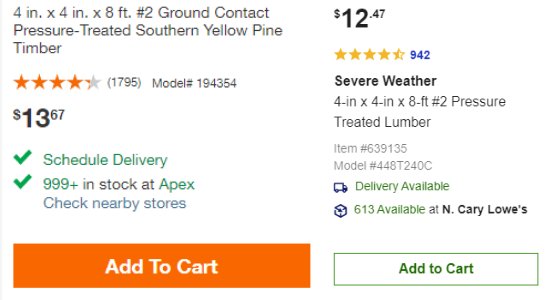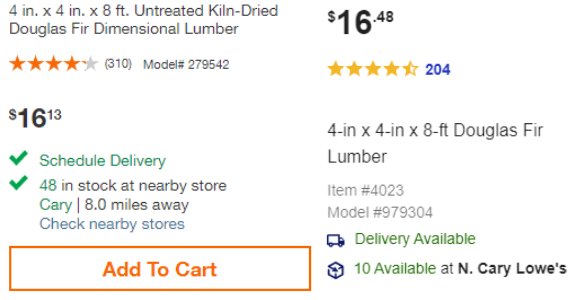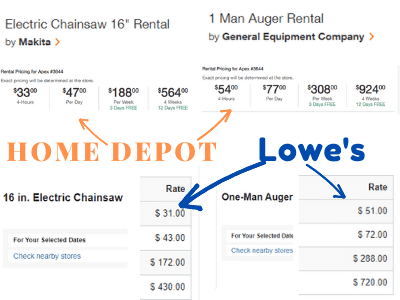Everything you need to know about Home Depot vs Lowe’s in 2022

Big-box home improvement chain stores are one-stop shops for for your home, from construction materials to furniture, accessories and home décor.
Of all home-improvement chain stores, Home Depot and Lowe’s are the biggest.
I have multiple stores from both chains within 30min driving from my house. Though my preferred store is Home Depot, I often source my woodworking project supplies from both stores.
For example, majority of supplies for my sandbox project was sourced from Lowe’s, whereas most supplies for my swing set project were sourced from Home Depot.
So I decided to document a detailed comparison between the two chains.
1. Home Depot vs. Lowe’s basic facts and figures
Basic facts and figures of the 2 big-box stores are listed in the table below.
| Home Depot | Lowe’s | |
| Public? | Yes | Yes |
| Founded | 1978 | 1921 |
| Headquarters location | Atlanta, GA, USA | Mooresville, NC, USA |
| Number of stores | 2200+ | 2200+ |
| Revenue | 132 Billion | 89 Billion |
| Number of employees | 400,000+ | 300,000+ |
| Website | Link | Link |
| Areas served | USA, Canada, Mexico | USA, Canada |
| Average interior store size | 105,000 sq. ft. | 112,000 sq. ft. |
| Average exterior store size (for garden products) | 24,000 sq. ft. | 32,000 sq. ft. |
| Sales per square foot | $543 | $431 |
You can see at first glance that Home Depot is 30% larger than Lowe’s’ in terms of revenue and employee count.
This is surprising given both have the same number of stores, and Lowe’s stores are actually bigger!
There’s only one explanation for the surprising result: Home Depot is more efficient with its sales than Lowe’s. The superior efficiency of Home Depot is apparent in the “sales per square foot” metric shown in the table.
2. Home Depot vs. Lowe’s prices. Who has better prices?
In general, Home Depot advertises slightly better prices than Lowe’s, but either store maybe cheaper than the other given a specific item. Also, Home Depot has a price match policy, and so does Lowe’s, meaning one store will price match the other if asked.
To provide an example for either store advertising cheaper prices, at the time of writing this post (January 2021), Lowe’s had a better price on 4″ x 4″ x 8′, grade #2, southern yellow pine lumber pressure treated with Micronized Copper Azole (MCA-C). See below for the snapshot I took from the the stores’ online catalog.

On the other hand, Home Depot had a better price on untreated, kiln-dried 4″ x 4″ x 8′ lumber. See snapshot below.

Since the price differences between the stores are small, it may not be worth your time researching prices between the two or pursuing a price matching with the stores’ staff, unless you’re buying a large volume of a specific item or buying a very expensive item like a home appliance.
I personally do not compare prices between the two. I prefer to just look at Home Depot for all my projects, and go to Lowe’s only when an item isn’t available at Home Depot.
For example, for my bedroom project with temporary walls, all but one supplies were sourced from Home Depot and Amazon.
Note: As mentioned, Home Depot has a price match policy, and so does Lowe’s. This price matching extends to even online competitors like Amazon! There are some restrictions however, like the item needs to be sold directly by the competitor and not a 3rd party seller using the competitors marketplace.
3. Home Depot vs. Lowe’s stock. Which is better?
Home Depot (HD) is a better investment than Lowe’s (LOW) based on the financial analysis of current market conditions. Notably, both have about the same valuation but Home Depot shows stronger growth potential.
If you’re an avid DIYer frequenting these stores, and if you invest in the stock market, it’s natural to wonder how these companies’ stocks are doing.
To elaborate on which is the better stock to invest at the time of writing this post (2022), let’s look at some financial facts and figures of Home Depot vs. Lowe’s.
3.1. Home Depot vs. Lowe’s financial figures
| Home Depot | Lowe’s | |
| Return in 2021 | 56.24% | 61.02% |
| 5-year return (2017-2021) | 209% | 263% |
| Revenue (Jan 31 2022) | 132 Billion | 89 Billion |
| Year-over-year 3rd quarter revenue increase (2020-2021) | 33.5 -> 36.8 Billion (9.8%) | 22.3 -> 22.9 Billion (2.6%) |
| Year-over-year 3rd quarter EPS increase (2020-2021) | 3.2 -> 3.94 (23%) | 0.92 -> 2.74 (197%) |
| Year-over-year 3rd quarter net income increase (2020-2021) | 3.43 -> 4.12 (20%) | 0.69 -> 1.89 (173%) |
| P/E ration (as of Jan 13 2021) | 27.28 | 22.2 |
You can’t go wrong with either stock, but Lowe’s looks to be a winner on some key measures and is a better place for your money as of Jan 2022.
3.2. Home Depot vs. Lowe’s financial ratios
| Home Depot | Lowe’s | |
| Working capital ratio (higher is better) | 1.13 | 1.19 |
| Quick ratio (higher is better) | 0.37 | 0.39 |
| EPS (higher is better) | 3.92 | 2.73 |
| Debt-equity ratio (lower is better) | 35.47 | -15.15 |
| Return on equity (higher is better) | 782.14% | 24,980.15% |
Lowe’s looks to be a winner on 5 of these 6 key ratios while Home Depot is winning 1. Here again, Lowe’s seems to be a better place for your money as of Jan 2022.
3.3 Home Depot vs. Lowe’s future plans
It’s expected that both giants will continue to grow in the coming years, even after the pandemic. Roughly two-thirds of revenue in home improvement comes from nondiscretionary things customers have no choice but to address. These include replacing a broken heater or appliance or fixing a leak, so the bulk of the business is stable. This, combined with the fact that some 50% of U.S. homes are older than 40 years and will need work in the coming years, makes for a bright future for both companies.
Home Depot
On August 4th 2020, Home Depot announced that it will open 3 new distribution centers in Georgia. This 18-month project is part of Home Depot’s plan to establish 150 new supply chains across the country. Home Depot hope that this expansion will make it accessible to 90% of the U.S. population.
Lowe’s
On August 12 2020, Lowe’s also announced that it plans to expand its supply chain by opening 50 delivery terminals over the next 18 months. This is expected to allow the company to improve its home delivery channels as well as cater to the increasing demand for home improvement products.
Lowe’s also announced a nationwide tool rental program earlier in August 2020. This may grow profits for the company substantially by expanding its client base.
Finally, Lowe’s has started a contactless delivery service on September 22nd, through its buy online and pick up in-store service. This will allow customers to get their orders in the same day while complying with the social distancing rules.
Have you enjoyed this post thus far? Do you have any questions or suggestions for improvement? Please leave a comment below. I’d love to hear from you.
4. Home Depot vs. Lowe’s during the COVID pandemic
Both companies have been killing it during the COVID pandemic. The pandemic-induced ‘nesting’ has fueled a home improvement frenzy across the US.
As more and more people began quarantining, some converted garages into home offices and gyms. Others transformed bedrooms into temporary classrooms, or transformed the yard to make it a relaxing escape.
The home improvement supplies have been experiencing shortage, but the demand for home renovations, repairs, and DIY projects have been on the rise during COVID.
I have observed the prices of common DIY supplies like 2x4s more than double during the pandemic!
There have been multiple times during the pandemic when I’ve gotten to the Home Depot parking lot on a Saturday, and seeing the long line, either returned home or gone to another store.
As some point, I began to do all my home improvement shopping on Sunday late afternoons to avoid the crowd.
5. Home Depot vs. Lowe’s lumber. Who has better lumber?
The quality of lumber, pressure treated, untreated, or kiln-dried, does not vary significantly between Home Depot and Lowe’s. Common, soft-wood lumber with grades 1 and 2 is what you’ll find most commonly in these two big-box stores.
Notes: If you aren’t familiar with lumber classification, soft wood is harvested from coniferous trees like pine, fir, spruce, and cedar. As the name suggests, they’re soft and can be dented with your fingernails.
Common (as opposed to select) lumber is used for construction and building projects (as opposed to fine furniture projects).
Grades 1 and 2 are the highest grades of common lumber on a scale of 5. They contain the least number of defects and knots among common lumber.
While the two big-box stores don’t differ much in lumber quality, that quality may not be good enough for your needs.
It’s very common to find defects in big-box store lumber. The most common defect is a bow or bend, which is warp on the face of a board from one end to the other.
The good news is that you can easily check for this defect before placing the board in your cart. The check can be done by looking down the length of the lumber from one end to the other, as shown in the picture below.
You may have to rest one end of the lumber on the floor while doing this kind of inspection.

Since the bow can be present in multiples faces of the board, do this inspection for 2 adjacent faces of the lumber.
For example, for a 2″ x 4″ x 8′ piece, you’d first do this inspection with the 2″ face pointing up (as shown in the pic above), which will help you easily detect the bow along the 4″ face.
Then you’d turn the lumber 90o and repeat the inspection, this time with the 4″ face pointing up.
Be sure to inspect every piece before putting it in your cart. The lumber aisles will have plenty of room for you to do this.
The inspection will take time and effort. Do not buy lumber from big box stores if you don’t have the time to inspect every piece.
Since you may be lifting off multiple pieces of lumber off the rack before you find the one that’s good enough for your project, it really helps if you take your favorite pair of work gloves to the lumber store with you when you go shopping.
This glove from Amazon is what I use for all my woodworking projects.
Lumber may have other types of defects too. Check out this link for a complete list of types of defects found in lumber.
If you do not have the time or not willing to put in the effort to inspect every piece of lumber, then buy from smaller, local lumberyards.
Compared to big-box stores, lumberyards offer a number of advantages, such as higher quality, more expertise, better selection, and superior customer service.
You’d think that prices at smaller, local lumberyards are always higher than those at big-box stores. But this is a myth. Its’ common for the prices at local lumberyards to be comparable to those at the big-box stores.
Have you enjoyed this post thus far? Do you have any questions or suggestions for improvement? Please leave a comment below. I’d love to hear from you.
6. Home Depot vs. Lowe’s customer service. Who provides better in-store experience?
In general Lowe’s provides slightly better customer service and shopping experience than Home Depot. The two metrics, however, vary significantly from one store location to another in both chains, as they’re greatly influenced by the management of a specific store location.
In J.D. Power 2020 U.S. Home Improvement Retailer Satisfaction Study of home improvement retailers, Lowe’s ranked 3rd with a score of 838 on a scale of 1000. In comparison, Home Depot came in 5th, with a score of 827.
Apart from inventory, prices and location, the biggest factor that affected the rankings in the JD Power study was friendly, knowledgeable service with a smile, provided in two minutes or less.
Historically, Lowe’s has taken a lead over Home Depot in the American Customer Satisfaction Index (ASCI) also. For example, Lowe’s has an average ASCI of 77.4 on a scale of 100 over 5 years, from 2015 through 2019. In contrast, Home Depot’s average is 76.6.
ASCI measures the customer experience of over 400 companies across 45+ industries, based on a survey of roughly 500,000 customers.
In the following subsections, let me provide some specific insights into why Lowe’s takes the lead in customer experience.
6.1. Home Depot vs. Lowe’s staff training
How well the staff of a retail store are trained has a lot to do with customers’ experiences at that store. Both Home Depot and Lowe’s heavily invest in training their staff.
Both chains follow similar training methods, which include two main parts:
- Computer training, where the employee takes video lessons. This part may involve some hands-on training as well, depending on the department. After the lessons, employees are expected to undergo an evaluation that tests their knowledge.
- Shadowing, where the employee tails another employee experienced in the department. The employee gets to watch, ask questions, and learn from the mentor or coach they’re tailing.
While both chains are similar in their training methods, Lowe’s recently seems to have gone further by building a physical, 15,000 sq.ft. training facility called Lowe’s University. This facility is aimed at fostering a customer-driven company culture, which is expected to translate into exceptional customer service.
The Lowe’s University facility is equipped with state-of-the-art training equipment, like virtual reality!
Note: Despite the investment that the big-box stores make in training their staff, you likely won’t find the same level of expertise at these stores as you do in specialty stores, like lumberyards and contractor supply houses. These specialty stores are often staffed by seasoned veterans of the trades – staff at general-purpose big-box stores cannot match that sort of expertise. If you have an unusual need, like an uncommon plumbing pipe, a specialty plumbing store is the place to be.
6.2. Home Depot vs. Lowe’s compensation and benefits
This is an important factor that influences customer service. How employees of a company treat customers is in part a reflection of how those employees are treated by that company.
Here too, Lowe’s takes the lead.
Lowe’s pays their employees slightly more and treats them better than Home Depot. Employees who have switched from Home Depot to Lowe’s have experienced a $1 to $3 pay increase.
Lowe’s also provides a better work culture than Home Depot. For example, Lowe’s provides part-time benefits and some time off during the weekends.
6.3. Home Depot vs. Lowe’s aisles. Who has better store organization?
In general, Lowe’s has brighter, cleaner, wider, and better organized aisles. This is perhaps because the staff at Lowe’s are better trained and compensated.
Other sources like this one and this one also confirm the superiority of Lowe’s’ store organization.
6.4. Home Depot vs. Lowe’s military discount. Who has better veteran discount?
Both Lowe’s and Home Depot offer a 10% discount to currently serving members or veterans of the US armed forces. However, Lowe’s applies this discount more generously than Home Depot.
Notably, Home Depot does not publicize much about its military discount, in stores or online. Home Depot’s military discount applies only to in-store purchases.
In contrast, Lowe’s has an officially published military discount program eligible people can enroll in. Once enrolled, members can obtain the discount either in stores or online.
7. Home Depot vs. Lowe’s return policy
Most new, unopened items can be returned within 180 days at Home Depot and 90 days at Lowe’s. Original receipt isn’t necessary as long as the order can be tracked.
The following table compares the return policies of the two retail giants.
Overall, the return policy is comparable between Home Depot and Lowe’s, but depending on what you’re buying one maybe better than the other.
For example, Home Depot offers a longer return period for general merchandise. On the other hand, Lowe’s has a more generous return policy for furniture and area rugs.
Complete up to date policies can be found here for Home Depot and here for Lowe’s.
| Home Depot | Lowe’s | |
| Period for most new, unopened items (exceptions below) | 180 days within purchase | 90 days within purchase |
| Period for major appliances | 48hrs, and only for defects and damage | 30 days |
| Period for electronics | 30 days | 30 days |
| Period for Power equipment | 30 days | 30 days, but only if unused |
| Period for Generators | 0 (not returnable) | 30 days, but only if unused |
| Restoking fee for special orders | 15% | 20% |
| Period for Trailers | 0 (not returnable) | 30 days |
| Period for paint | 30 days, but only for correction or exchange | 30 days |
| Period for furniture and area rugs | 30 days | 90 days |
| Receipt needed for return? | No, as long as they can locate your order, e.g., with your credit card | No, as long as they can locate your order, e.g., with your credit card |
7. Home Depot vs. Lowe’s tool rental
Both Home Depot and Lowe’s have a tool rental program that covers a wide variety of tools, ranging from wheel barrows to stump grinders. In general the rental prices are cheaper at Lowe’s, but Home Depot offers a wider selection.
7.1. Home Depot vs. Lowe’s tool rental prices
Overall, I found Lowe’s’ tool rentals to be a bit cheaper than Home Depot after comparing the prices over several tools.
The pic below shows store catalog snapshots (as of January 2021) comparing the rental prices for a 16″ electric chainsaw and a 1-man auger between the two stores.
You can see that the Lowe’s prices are a few dollars cheaper for a 4-hour rental. Lowe’s is significantly cheaper as you rent the tools for longer periods.

7.2. Home Depot vs. Lowe’s tool rental availability
Home Depot takes a clear lead over Lowe’s in the availability of tool rentals. It seems Lowe’s’ tool rental program isn’t available in most stores.
For example, for the 1-man auger listed in the previous section, Home Depot had one available for rent in multiple stores within 20 miles from my house.
On the other hand, the Lowe’s store closest to me with a 1-man auger rental was 100+ miles away!
7.3. Home Depot vs. Lowe’s tool rental selection
Home Depot takes a clear lead over Lowe’s in the selection of tool rentals.
As of January 2021, Lowe’s rents tools in 20 different categories. In comparison, Home Depot rents tools over 40+ different categories.
For example, you can rent a 5-ton excavator from Home Depot. You can’t from Lowe’s!
Have you enjoyed this post thus far? Do you have any questions or suggestions for improvement? Please leave a comment below. I’d love to hear from you.
8. Home Depot vs. Lowe’s truck rental
Both Home Depot and Lowe’s offer truck rentals at the store on a first come, first served basis. Standard flat-bed truck rentals are cheaper at Lowe’s, but Home Depot offers a much wider selection of vehicles to choose from.
The table below compares the truck rental programs from the two chains.
| Home Depot | Lowe’s | |
| Hourly price | $19 for the first 75min, $5 for each 15min after | $19 for the first 90min, $5 for each 15min after |
| All day price (for a flatbed) | $120 | $89 |
| Purchase necessary? | No | No |
| Reservations available? | No | No |
| Selection | 8′ flatbed, 10′ flatbed, van, box truck, and Penske trucks | 8′ flatbed only |
| Deposit needed | $150, refundable | Unclear |
Note that neither store allows you to reserve the trucks in advance. This is a huge drawback of renting trucks from either store.
Imagine buying a bunch of stuff that you need to haul in a truck, and then finding out at the checkout that there’s no truck available to rent.
You have 2 options at that point: return everything, or wait indefinitely for a truck to come back. Both options will be a major waste of your time.
Now, in my experience, staff at some Home Depot stores will let you put a hold on an available truck when you get to the store so that the above situation can be avoided. They won’t start the clock on the rental until you actually finish shopping.
But you still have to risk getting to the store and finding that no truck is available. This has indeed happened to me.
Most Home Depot or Lowe’s have only a few trucks available, and in my experience, you’ll find that those trucks have already been rented when you get to the store.
Though you can always call ahead on your way to the store to make sure at least one truck is available to rent, there’s no guarantee that it will still be available when you actually get to the store.
For these reasons, I no longer rent trucks from Home Depot or Lowe’s. Instead, I rent from U-Haul, where you can reserve your truck or van in advance.
Not only can you reserve with U-Haul, if your rental lasts a few hours, U-Haul will also be cheaper than either Home Depot or Lowe’s, as long as you don’t purchase any of their add-ons. Check out my temporary wall project, where I rented a U-Haul van for $36.64 for 3 hours.
Had I rented a similar van from Home Depot, it would’ve cost me $54!
9. Home Depot vs. Lowe’s online experience and e-commerce
If there’s one area Home Depot is leaving Lowe’s in the dust, it’s in e-commerce and shopping experience online. Home Depot is 5th in the 2020 Top 1000 Report, which ranks leading online retailers in the US by web sales. In contrast, Lowe’s is 22nd.
Home Depot is only behind e-commerce giants Amazon, eBay, Apple, and Walmart. It’s believed that Home Depot’s online inventory is about four times greater than Lowe’s’.
Home Depot began its online transformation much earlier than Lowe’s. Lowe’s admitted in 2019 that it was sitting on top of a decade old platform!
In fact the Lowe’s website crashed during Black Friday sales in 2018. Ouch!
It’s not just in inventory and sales that Home Depot takes the lead. The entire customer experience itself is better with Home Depot.
As an experiment, I tried to get hold of a customer representative on both Home Depot’s and Lowe’s’ websites.
I was actually able to get to a real person within minutes of initiating the chat on Home Depot’s website.
See my chat transcript with Home Depot’s rep below. I started the chat with a Virtual Assistant (chatbot) at 8:27pm.
I was connected to a real person at 8:29p. I got the info I wanted at 8:31p. In this case, I simply wanted to know how much Home Depot charges for an all-day truck rental.

When I did the same with the Lowe’s website, I couldn’t reach a real person. See my chat transcript on the Lowe’s website below.
I started the chat with Lowe’s Virtual Assistant (chatbot MyLo) at 9:53.
MyLo simply asked me to contact my local Lowe’s.
The all-day truck rental price doesn’t vary from store to store at Lowe’s by the way. It’s fixed at $89 (as of January 2021).
The Lowe’s chatbot was inaccurate and unhelpful.

Lowe’s is well-aware of its online problem. Lowe’s has already re-platformed its e-commerce site on Google cloud, making it more stable.
It’s expected that Lowe’s will be to add more customer-facing features to its website soon. These include as one-click checkout, the ability for customers to schedule or change a delivery time, and better graphic.
10. Home Depot vs. Lowe’s professional services
In general, Home Depot it substantially more popular with professional contractors than Lowe’s. Professional contractors account for 40% of Home Depot’s revenue, but it accounts for only 30% of Lowe’s.
What’s interesting is that pros make up only 3% of Home Depot’s customer base. These pros include remodelers, general contractors, handymen, property managers, building service contractors, and specialty tradesmen, such as installers.
Home Depot’s lead in professional services seems intentional in its branding and store organization.
Home Depot features tall shelves, the highest only accessible by forklifts. You’re likely to find products that miss signage and tags at Home Depot.
This industrial aesthetic gives the impression that the store is geared toward home improvement professionals.
Lowe’s on the other hand uses a blue-and-white color scheme. Lowe’s stores often feature more elaborate floor displays or themed products such as patio sets. You’re less likely to find products that miss tags or labels at Lowe’s.
Overall Lowe’s provides the impression of a store that’s geared more toward DIYers and women.
Aside from branding and store organization, there are other reasons like the following why pros prefer Home Depot.
- Bulk pricing: Home Depot offers 4000+ products at bulk pricing (15-30% off). In contrast, Lowe’s bulk pricing catalog includes only 2000+ items. Lowe’s does offer up to 50% off on some bulk pricing items, but this higher discount isn’t sufficient to make up for limited selection. It’s worth noting, however, that both stores have a price matching program. Either store should match price with the other, but this may require extra time with customer service.
- Faster curbside pickup: Home Depot states that most items are ready for pick up with just a few hours after order. Lowe’s in-store pick up, however, seems to need a lot of improvement in terms of delivery speed. The disparity may actually have to do with Home Depot having superiority in technology.
- Exclusive brands: Professionals are very brand conscious. When it comes to exclusive brands, Home Depot has a better selection, with well-established brands, and better quality. For example, Ryobi, a Home Depot tool brand, is overall better than Kobalt, a Lowe’s tool brand. Similarly, Anderson, a Home Depot Windows brand, is better than Pella, a Lowe’s brand. And, Behr, a Home Depot paint brand, is better than Valspar. Table below provides a complete list of Home Depot and Lowe’s exclusive brands.
| Home Depot | Lowe’s | |
| Tools | Husky, Ryobi, RIGID | Kobalt, Task Force |
| Windows | Anderson | Pella |
| Paint | Behr, Glidden | Valspar, Sherwin-Williams |
Have you enjoyed this post? Do you have any questions or suggestions for improvement? Please leave a comment below. I’d love to hear from you.
